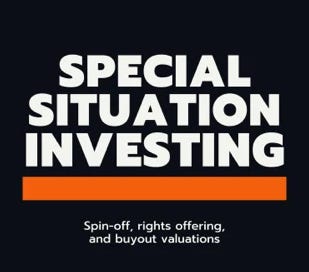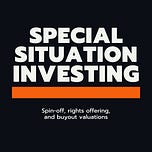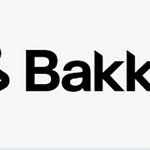Welcome to Episode 81 of the Special Situation Investing show where we’ll discuss how to use long-term pristine collateral as a leveraged funding source for small but asymmetric bets.
Nassim Taleb’s barbell portfolio offers investors a framework that exposes them to an investments upside potential while simultaneously protecting them from catastrophic loss. This construction avoids so called “medium” risk portfolios that in Taleb’s estimation are actually high risk portfolios with limited upside. To oversimplify his thesis the barbell portfolio would see an investor put a high percentage, say 90%, of his funds into extremely safe assets, think gold bars or cash. These are assets that have almost no downside. The remaining 10% or less of the portfolio would consist of very high risk and high potential return investments. Out of the money options, leveraged funds and other such investments would make up this smaller portion of the portfolio.
The idea, of course, is that your downside risk is known and limited but your potential upside is unlimited which skews the portfolio towards high returns. In the worst case, your high risk assets could all go to zero and only cause a 10% portfolio loss due to the majority of your investment being in ultra safe assets but all the while the 10% of the portfolio that’s exposed to high returns could have near unlimited upside.
Over the years, I’ve slowly combined Taleb’s barbell approach with my value investing background and have landed on the following strategy. I keep the majority of my portfolio in what I would consider extremely safe investments, investments that any regular listener to the podcast would be familiar with: royalties, streaming companies, exchanges, and brokers. I hold a few positions in solid brands with little to no debt that I’ve owned for decades but those are essentially a legacy of my pure “Buffett style” investing days.
When selecting investments, I picture my grandchildren inheriting the stocks and try to imagine which companies will last and which companies will go to zero. I want a company that will illicit a “grandpa was a genius” response and not a “what the heck did xyz company even do, grandpa was an idiot” response. In my estimation, there is a good chance that humans will need oil, minerals, exchanges, brokers and a few other things in 100 years and to the extent I can revenue share with those businesses I feel secure thinking that these investments won’t go to zero.
With these “all-weather” businesses making up 90% or more of my portfolio the remaining 10% is free to hold moonshot style positively skewed investments. Bitcoin and other asymmetric assets fit into this category as each of them have the potential to increase by 100x or more or to go to zero. This is in contrast to an oil royalty company which has very little chance of going to zero but is also unlikely to increase by 100x over a short period of time.
The only flourish that I’ve added to the barbell portfolio, and I realize that claiming to add anything to Nassim Taleb’s work is a risky proposition, is the idea of funding the high risk 10% of the portfolio with the 90% uber safe portion of the portfolio. Selling out of the money call options on positions that I’d be comfortable parting with and selling puts in companies I’d like to own generates income which then purchases asymmetric investments in the 10% part of the portfolio. Without going into great detail, shorting path dependent investments creates another funding source for the asymmetric 10% of your portfolio and allows you to continually grow your investments without an external funding source.
Because debt and leverage are terms used near synonymously, and because I largely avoid debt in my personal life, I was resistant to the idea of leverage for many years. I still maintain a healthy respect for leverage but have in recent years allowed myself to use it when the downside can be controlled.
A few examples might clear this up. Using cash in my account to back up the sale of a covered put, I can sell puts in a security that I’m interested in owning. These would be securities that fit into the uber safe 90% portion of the portfolio. If the option depreciates significantly in a short period of time then I’ll buy back the option at a lower price and use the difference between the original sale and the reduced buyback price to fund the purchase of another investment. Alternatively, if the security is put to me then I’ve added another uber safe security to my 90% portfolio and have a little extra cash from the sale of the put that can go towards funding new investments in the 10% portion.
Selling out of the money calls can have a similar effect on your portfolio as you’re able to generate cash from the sale of the call to fund more 10% investments. In the worst case, you’re forced to part ways with one of you’re holdings but you’re selling it at a predefined strike price that you’ve already determined is acceptable to you, otherwise you wouldn’t have sold the option to begin with. With both calls and puts I tend to buy back the option if it depreciates well ahead of the options standard decay rate. While selling prior to expiration doesn’t yield the full profit you might have earned by holding the option to maturity it does put cash in your brokerage account that otherwise wouldn’t have been there and removes the possibility of seeing the option exercised.
Without going into great detail, short selling very specific instruments generates extra income without undue risk as long as you understand what you’re selling short. Selling a bond short for example doesn’t carry the same unlimited risk profile that normally dissuades investors from short selling because the price of the bond if held to maturity is fixed. In other words, if you hold the position until the bond matures you know exactly what price you must buy it back at and aren’t exposed to the risk that goes with shorting most equities.
In any case, using the uber stable 90% of your portfolio as collateral to generate leveraged income that funds the 10% can be an effective way to grow your investments safely using a mostly barbell approach. You’re already holding safe assets but rather than buy and hold alone you’re using the uber safe 90% as collateral for very limited leveraged funding of the 10%. The key is understanding exactly how the portfolio would perform if every option were exercised and every short went against you. You have to be able to easily survive a worst case scenario in order to structure your investments this way so that you’re never a forced seller.
Warren Buffett avoids debt and advises others to do the same but his insurance float is surely a form of leverage and one that could, in theory, get him into trouble if he pushed it to far. Buffett uses insurance premium payments to fund an investment portfolio knowing that he will have to pay claims with some of that money in the future. To stay solvent, he must insure that he always has enough cash on hand to survive a terrible year in insurance without having to sell investments and certainly without having to sell investments at a loss. Knowing that poor management of this system could lead to ruin does not dissuade Buffett from using the leverage available in his insurance business in a prudent way. Neither, in my opinion, should we avoid intelligently managed margin and options funding strategies available to us in our own accounts.
Once again, the key ingredient is to own pristine collateral in the safe 90% of your portfolio. Ask yourself the following question, will the grandchildren look back in 60 years and wonder what you were thinking by purchasing xyz company or will the decision still make sense all those years later? A fine example of this long term thinking can be found in the The Voya Corporate Leaders Trust (LEXCX) which was created 88 years ago in 1935 and has outperformed 96% of its peers since that time. The source of the funds success stems from just a few simple rules and the discipline to execute them consistently over nearly a century
At its founding the trust purchased the 30 largest publicly traded companies in the US, excluding banks and financials. Next, the funds founders ruled that no stocks could be sold unless they were delisted or had their dividend suspended. New stocks, gained through mergers and spin-offs, were held based on the same simple criteria and this policy allowed the fund to slowly diversify its holdings over time. Following this simple policy the fund eventually held shares of both Exon Mobile and Berkshire Hathaway. That a fund following such a simple rule set and trading in increments of years and decades instead of hours and days could beat out the S&P 500 for decades on end is an incredible testament to long term thinking and one that can inform our own investment decisions.
Owning debt free “all weather” style streaming, royalty, exchange and brokerage businesses and holding them for the long term like the Voya Corporate Leaders Fund is a way to capitalize on the funds long term approach while simultaneously removing some of the business risk associated with the standard businesses that the fund owned. Likewise, structuring your portfolio in a barbell manner with 90% in extremely safe investments and 10% or less in moonshot style asymmetric bets allows you to limit downside while still maintaining exposure to an asymmetric upside payoff. Finally, layering very well understood and controlled leverage onto the safe 90% of your portfolio allows the safe assets to fund additional asymmetric bets in the smaller 10% of your holdings.
When combined, I believe that this structure captures the best attributes of the Voya Corporate Leaders Trust, Taleb’s barbell portfolio and classic value investing. Investors working within this model can think in terms of centuries and not days, can maintain limited downside risk, and can retain exposure to asymmetric upside all within the same portfolio. If nothing else we hope that sharing our thoughts on this topic has fueled your own thinking on portfolio construction and perhaps even caused you to rethink some of your own presuppositions.
We love sharing our thoughts and research with all of you and we ourselves benefit from your insightful feedback.
With that we wrap up Episode 81 of the show and look forward to seeing you again next week.
Top listens from last week









Share this post